Solid Fuel Ramjet Engine, SFRJ, CFD Simulation, ANSYS Fluent
$200.00 $100.00 Student Discount
- In this project, a solid fuel ramjet (SFRJ) engine has been numerically simulated by ANSYS Fluent software.
- We design the 2-D model by the Design Modeler software.
- We Mesh the model with ANSYS Meshing software. The mesh type is Structured, and the element number equals 35,224.
- We use the Species Transport model to define the combustion process.
To Order Your Project or benefit from a CFD consultation, contact our experts via email (info@mr-cfd.com), online support tab, or WhatsApp at +44 7443 197273.
There are some Free Products to check our service quality.
If you want the training video in another language instead of English, ask it via info@mr-cfd.com after you buy the product.
Description
Description
A propulsion system that creates thrust by compressing ram air is known as a solid fuel ramjet (SFRJ) engine. Simply put, it is an air-breathing engine that burns solid fuel using oxygen from the atmosphere instead of a fuel oxidizer carried inside the engine. The structure of an engine is typically made up of an air inlet, a combustion chamber where solid fuel is burned, and a nozzle from which exhaust gases are released to generate thrust. According to the ram effect theory, a solid fuel ramjet’s (SFRJ) forward motion compresses entering air before combustion. Here is a detailed explanation of how it operates:
– Air Intake: The ram action causes air to be driven into the intake as the SFRJ advances.
– Compression: The incoming air is compressed as the engine moves ahead.
– Combustion: In the combustion chamber, where the solid fuel is present, the compressed air enters. The fuel burns due to the compressed air’s heat igniting it.
– Thrust Production: When fuel is burned, hot gases are created that expand and are expelled from the engine’s back nozzle. This force causes the engine to move forward.
Due to their high efficiency and speed, SFRJs are mostly used in the aerospace and defense industries.
In a Solid Fuel Ramjet (SFRJ), the fuel flow might be either slower or faster than the speed of sound, which is determined by the Mach number at the entry point.
When the mixture of fuel and oxidizer in the combustion chamber travels at a speed lower than the sound speed, it is called Subsonic Flow (Mach number < 1). This allows pressure changes or information to move against the flow, implying that downstream changes can influence the upstream flow. In terms of an SFRJ, this could impact the combustion efficiency and the thrust produced.
The 2D model is created in design modeler and meshed in ANSYS Meshing software 35,224 elements.
Methodology
In this project, we simulated an SFRJ with Hydroxyl-terminated polybutadiene, HTPB, as the solid fuel, and the inlet air is considered subsonic flow because the Mach number is 0.9. the model has two inlets, one entering the air and the other entering the fuel. Also, the cone half angle of the diffuser is 20 degrees. To calculate the inlet velocity of air based on Mach number, we used the following formula :
V inlet=M×√(γ×R×T)
In which the γ presents (Cp/Cv) that equals 1.4 for air, the R represents the specific gas constant that is 287 for air, and the T presents absolute temperature. This way, the air velocity inlet is computed as 311.5[m/s], which equals 0.94 [kg/s] as the mass flow inlet.
The air comes in through the diffuser inlet, and the HTPB comes in via the fuel inlet to the chamber, and the combustion happens via the reaction below:
The species transport model defines the reaction and models the combustion in the chamber. It should be noted that volumetric and dissipation rates are activated in the species model.
The turbulence of the flow is simulated with the Realizable K-ε model, which is suitable for this problem.
Conclusion
Today, SFRJ can have a chamber temperature of up to 2900 K. Our simulation shows that the maximum temperature of the combustion occurring in the chamber reaches 1485 K, which is desirable T as a result.
The temperature and velocity contours of the processes in the simulated SFRJ are presented. Also, the oxygen and CO2 mass fraction contours are presented to show how the reactants and products are distributed via this reaction and simulation process.
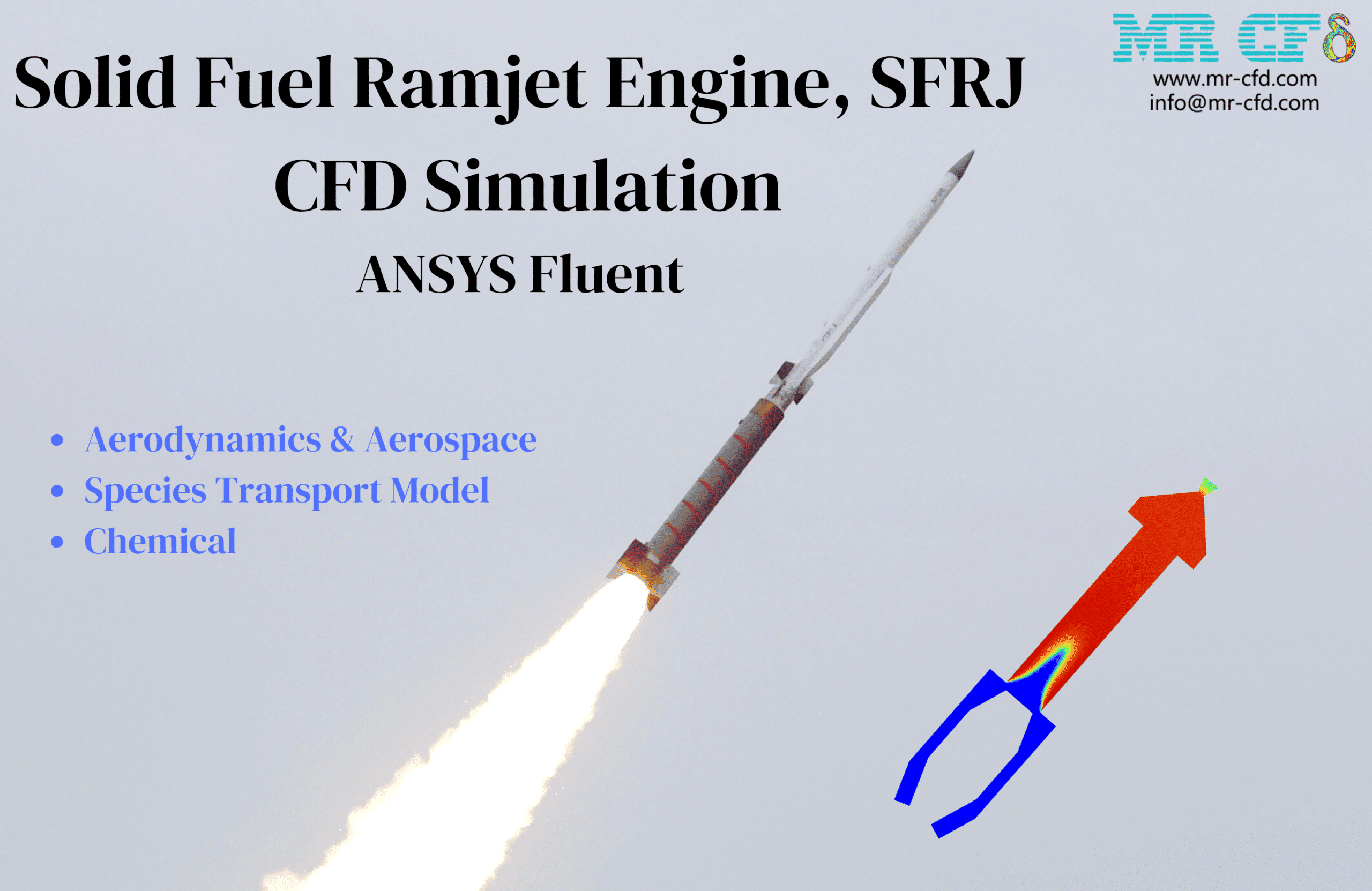
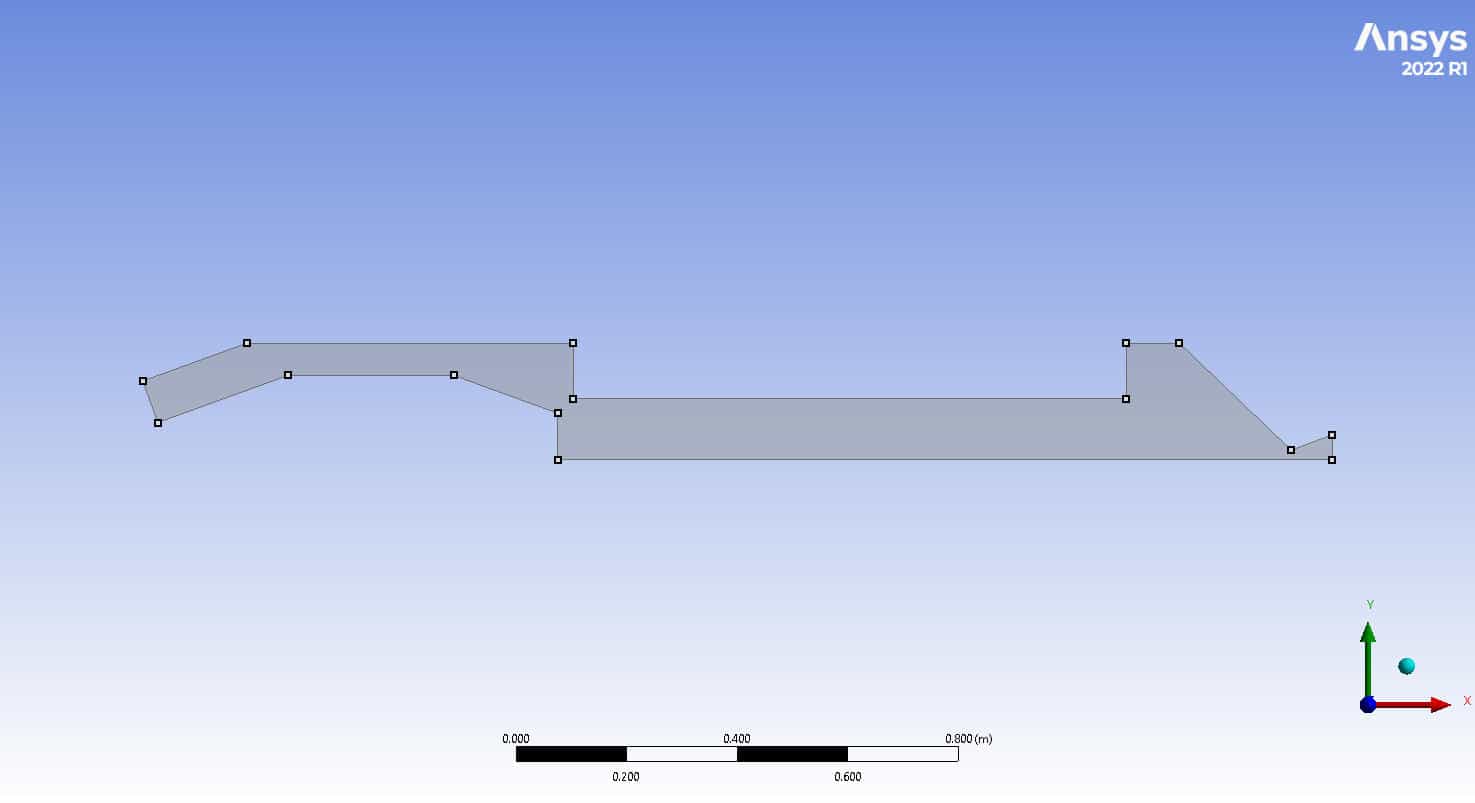
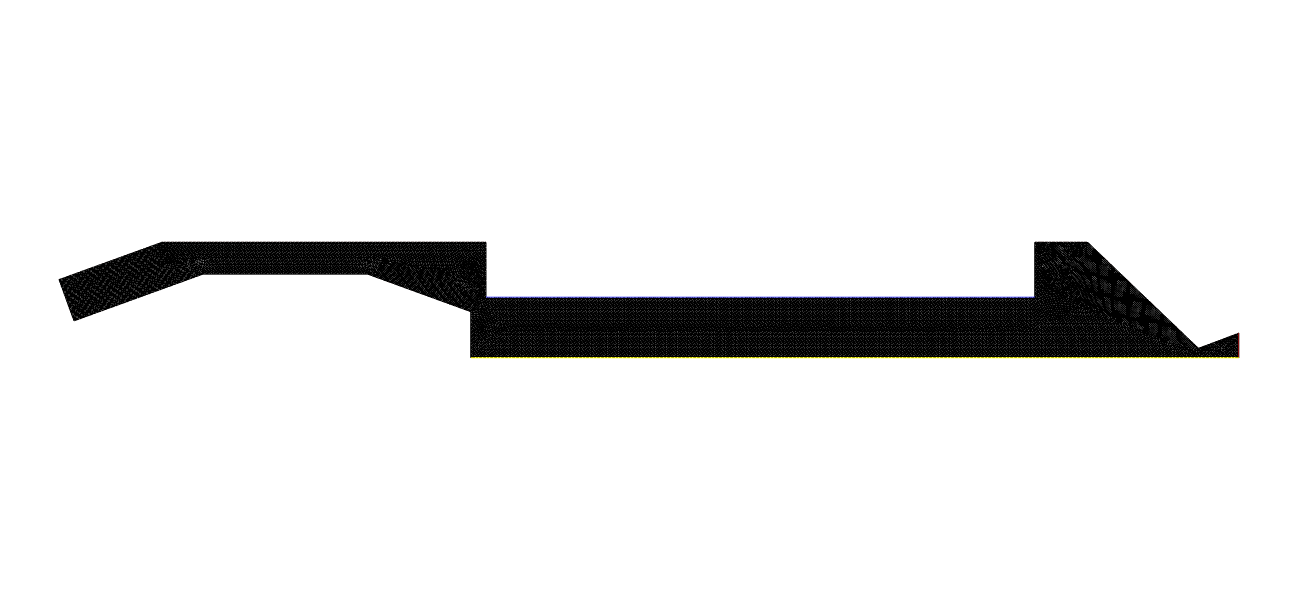
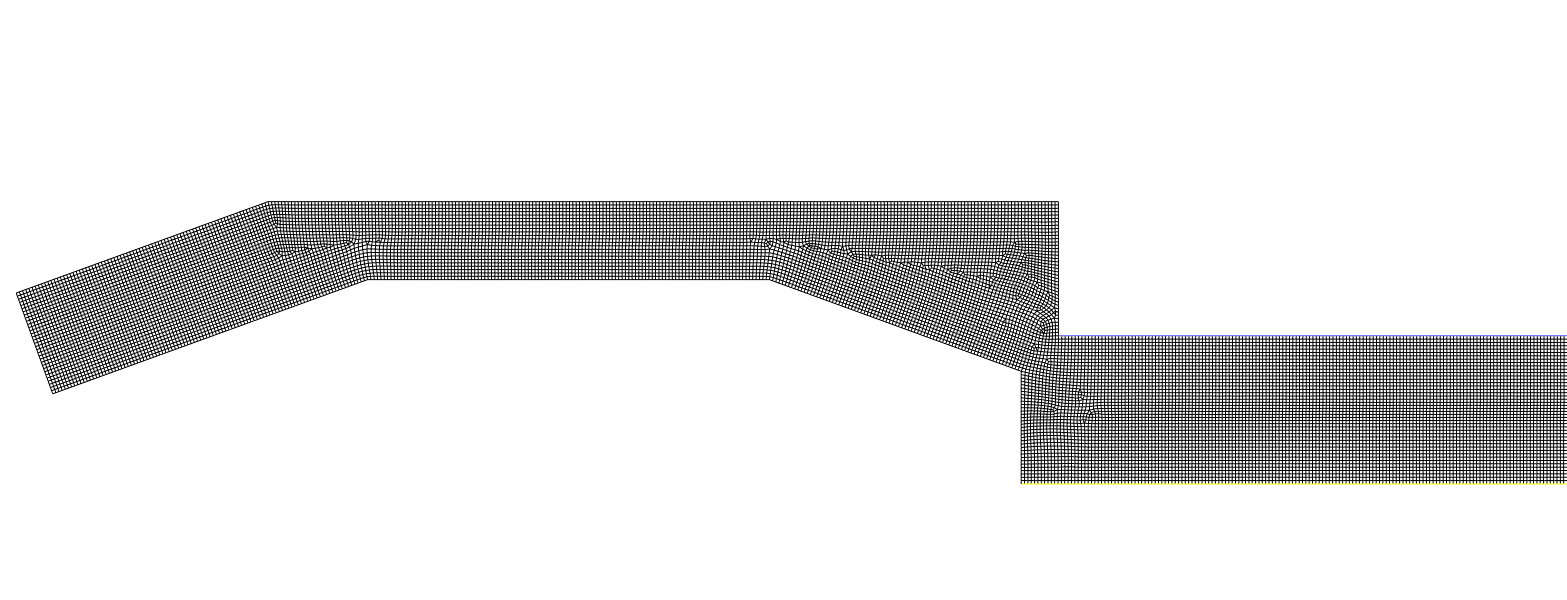
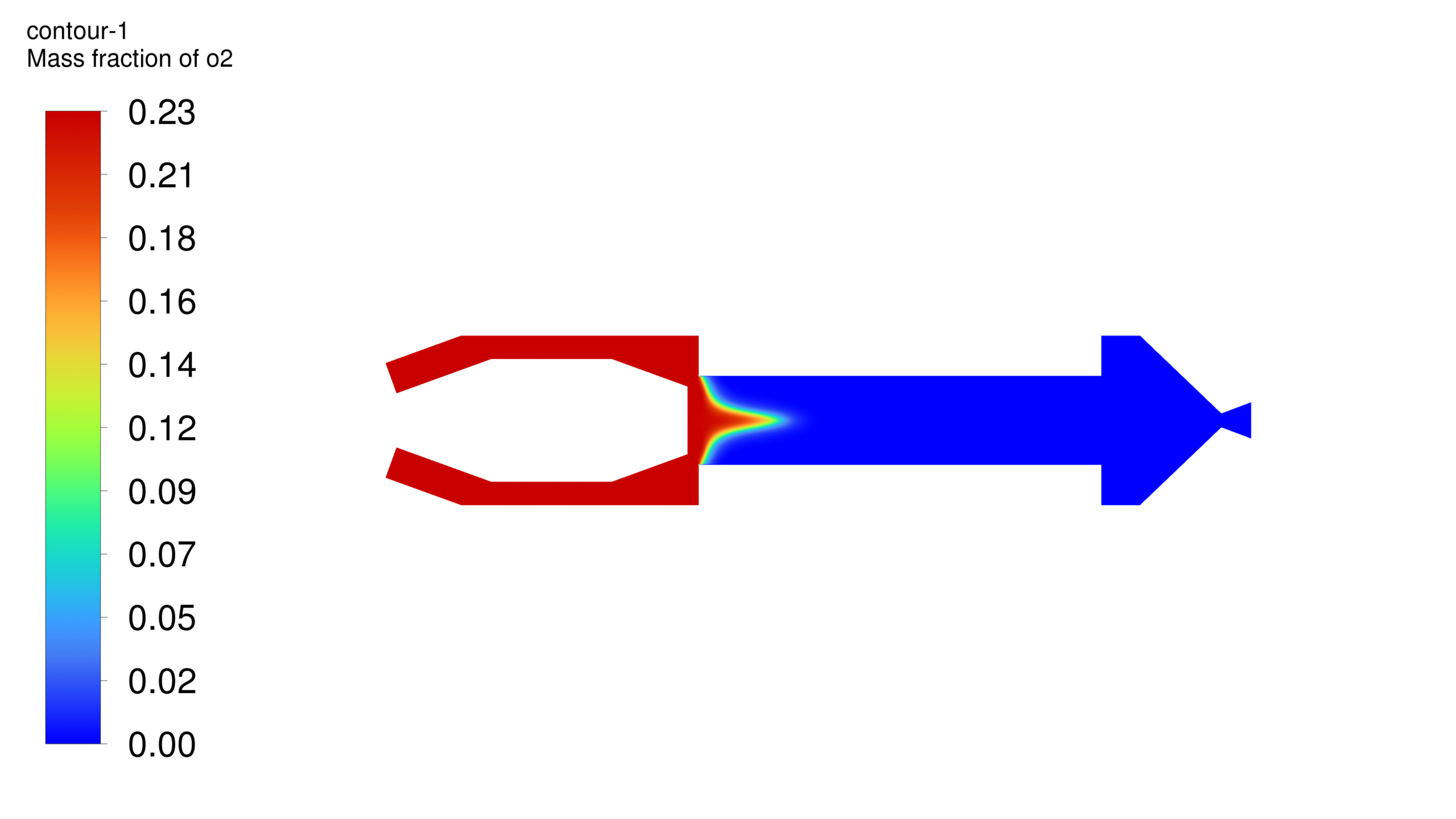
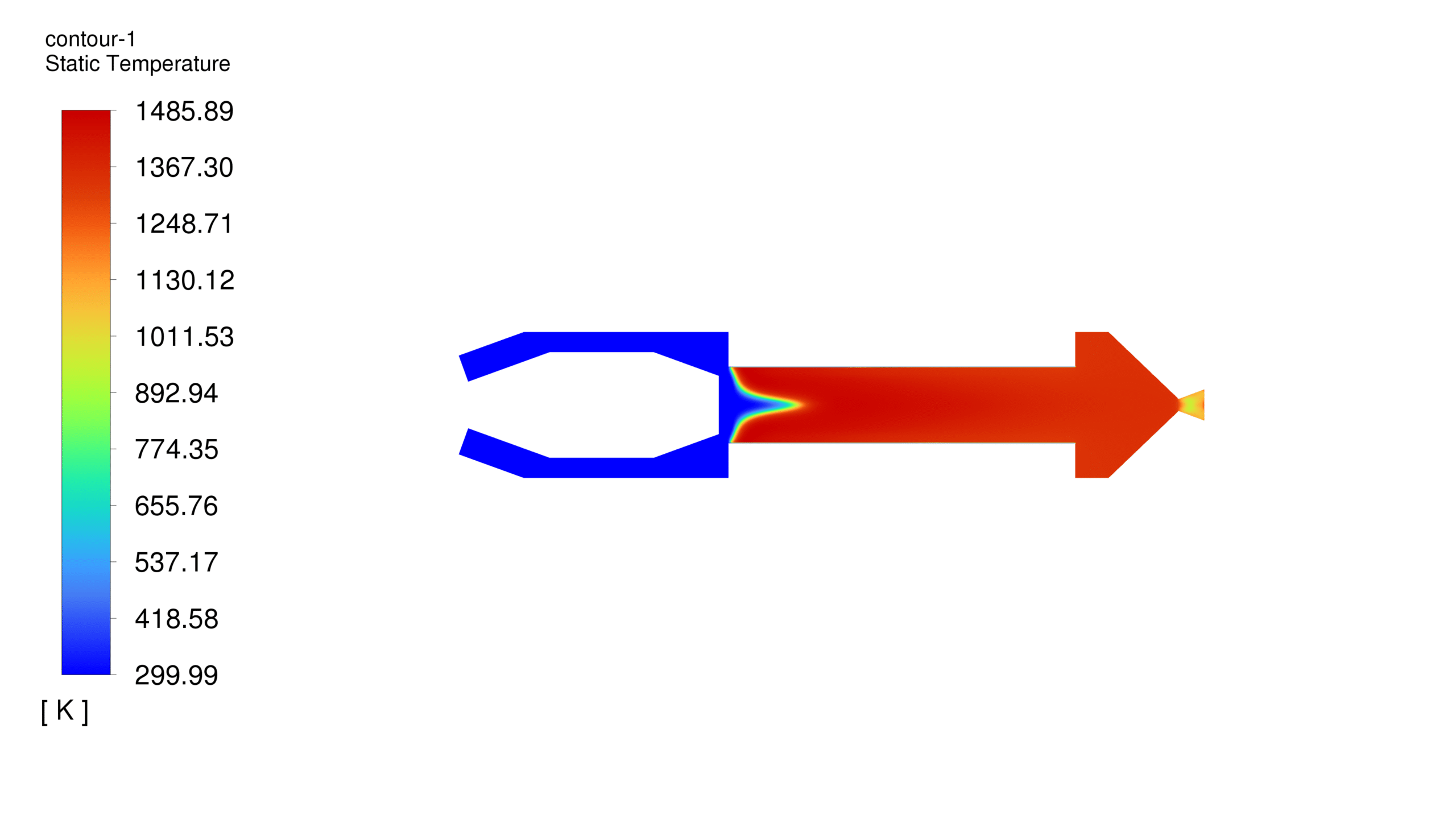
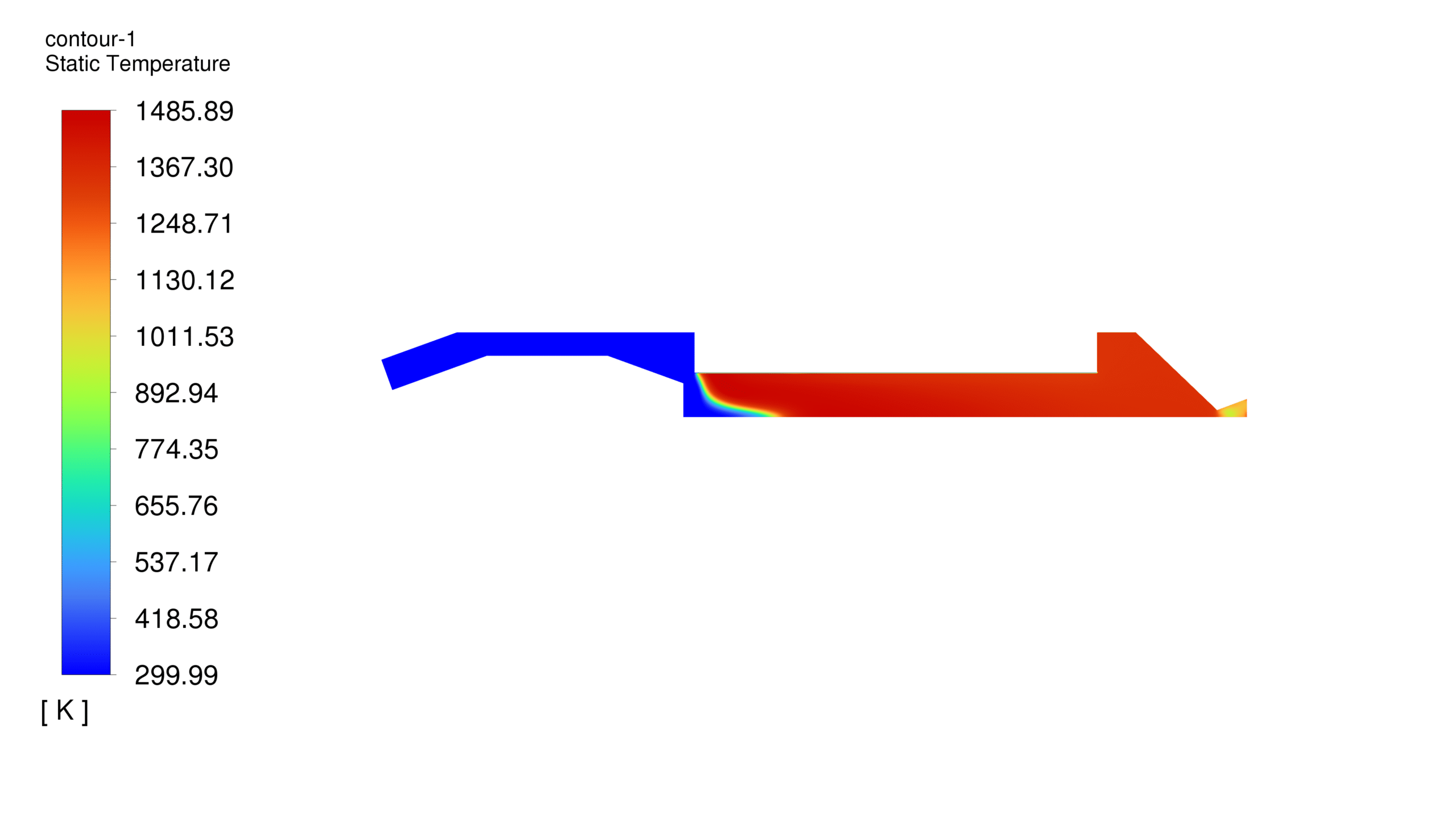
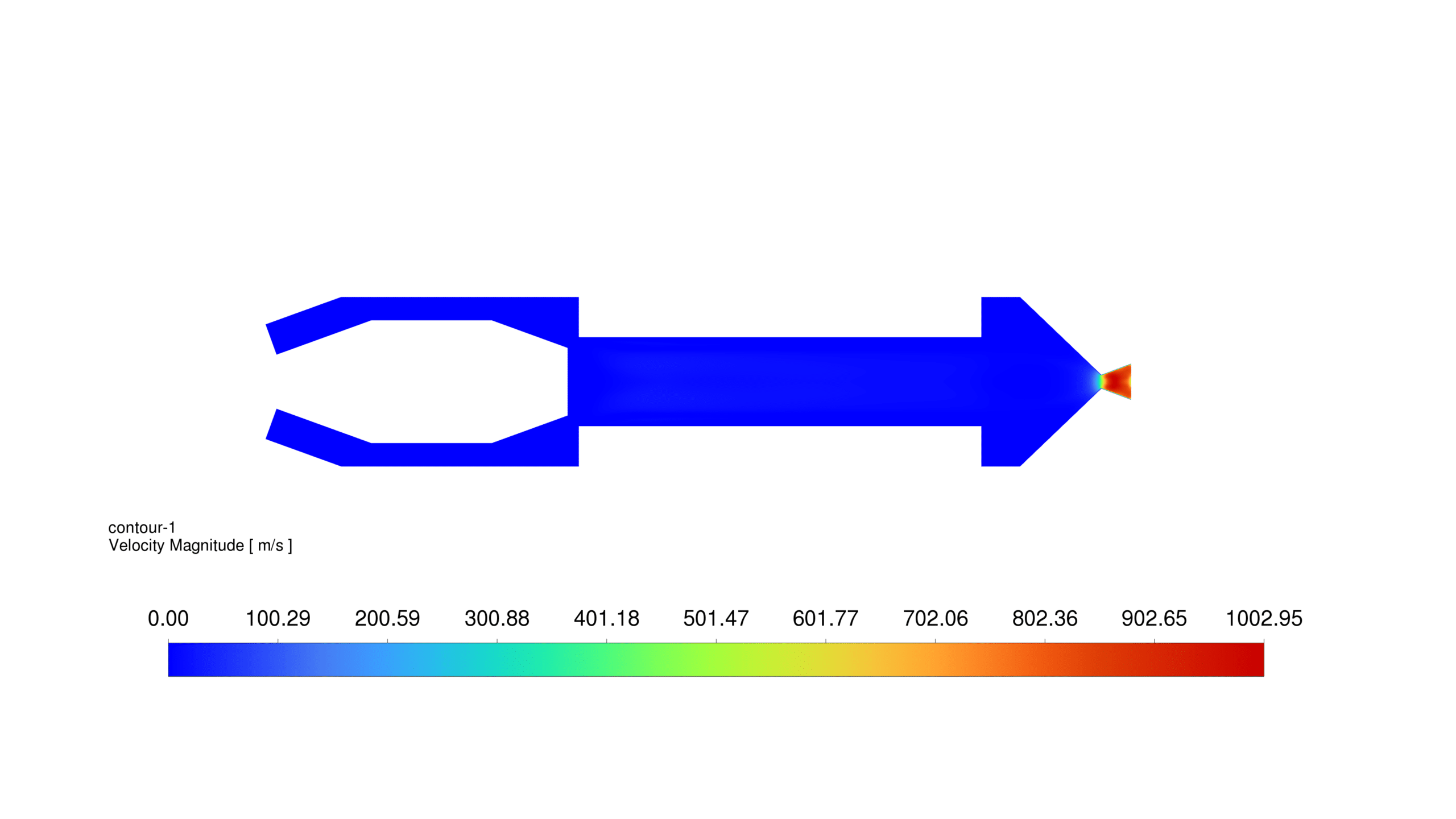
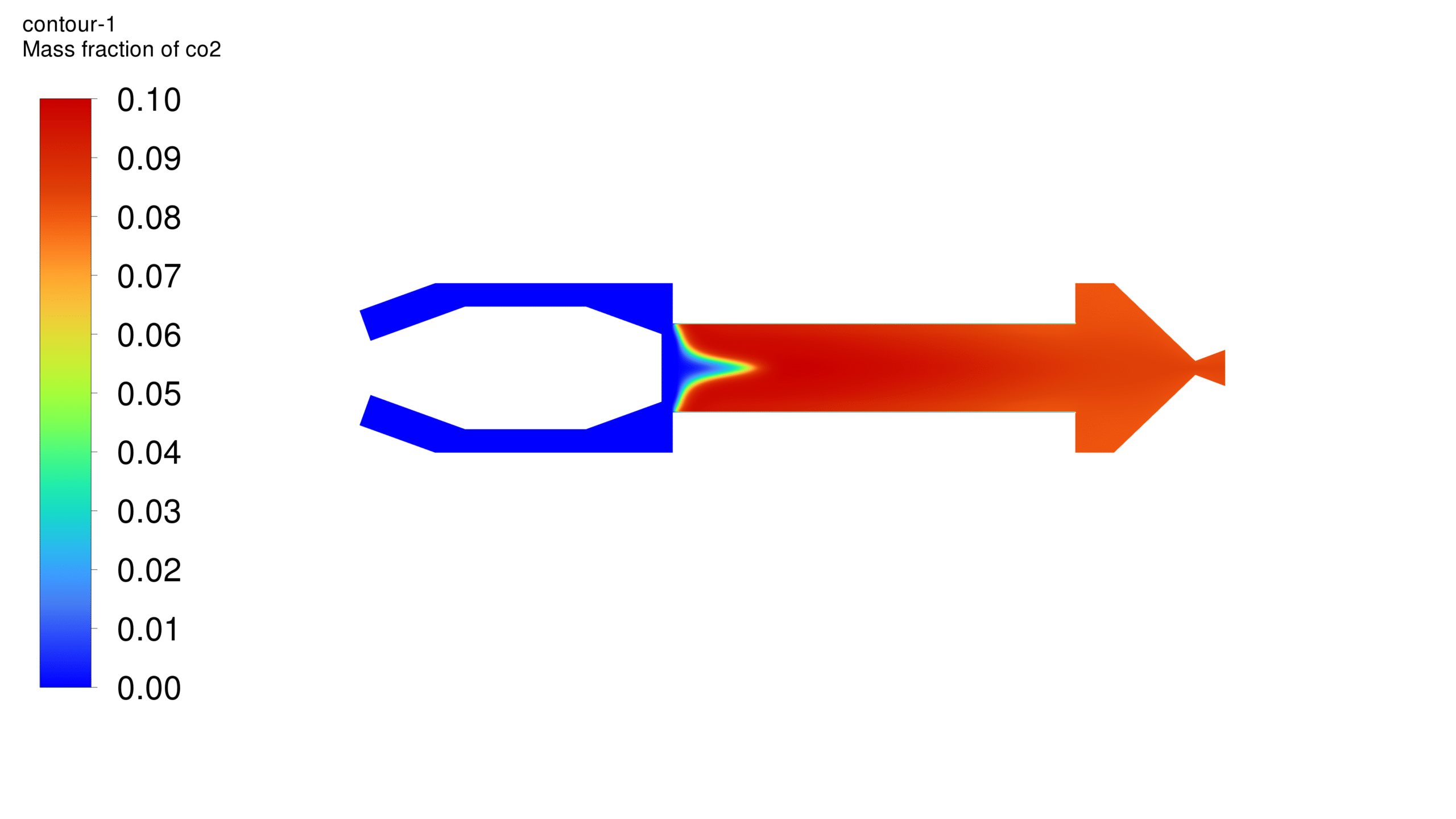
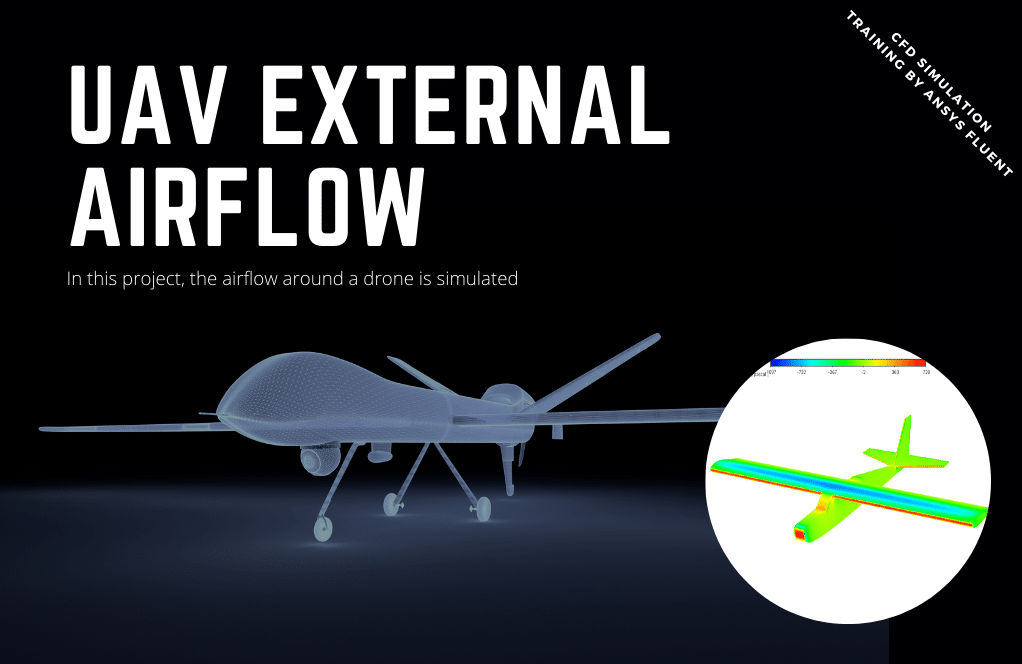
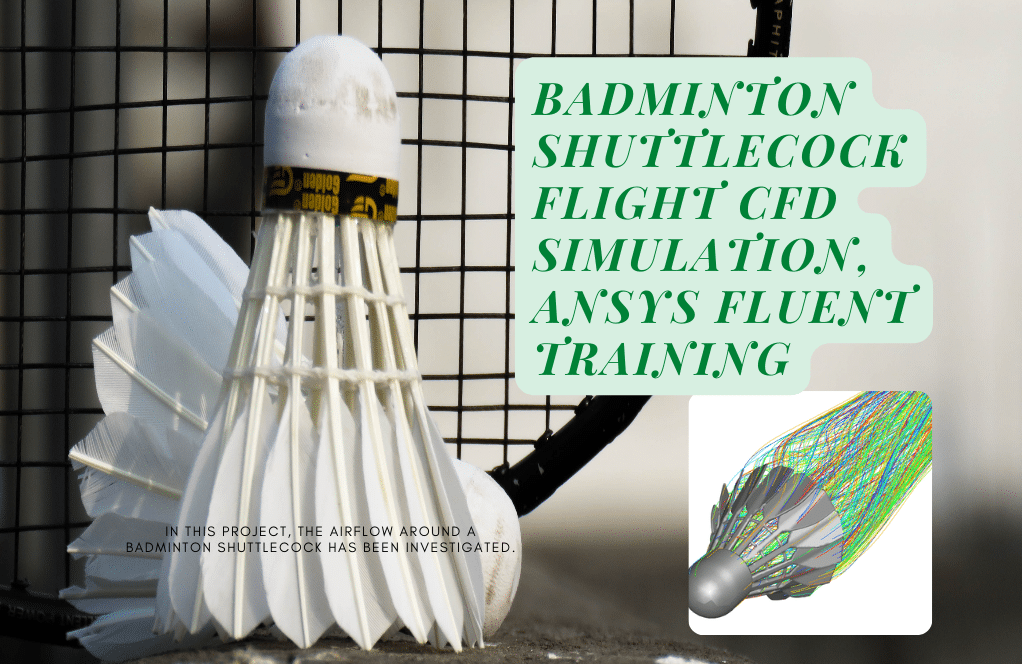

Fiona Boyle –
What material properties are taken into account for the solid fuel used in the simulation of the SFRJ engine?
MR CFD Support –
The simulation uses Hydroxyl-terminated polybutadiene (HTPB) as the solid fuel for the Solid Fuel Ramjet (SFRJ) engine. Properties such as density, specific heat capacity, thermal conductivity, and the reaction rate parameters specific to HTPB would be considered in the simulation to accurately model the fuel’s combustion and its interaction with incoming air.
Tamia Ernser –
I’m so impressed with the comprehensive analysis provided in the simulation of solid fuel ramjet (SFRJ) engines. The temperature and velocity contours helped me understand the combustion process so much better. Thank you for such an informative product.
MR CFD Support –
Thank you for your kind words! We’re delighted to hear that our simulation of the solid fuel ramjet engine helped enhance your understanding of combustion processes. Your feedback is appreciated, and we’re glad you found the information detailed and informative.
Moises Kilback –
I’m fascinated by the solid fuel ramjet engine simulation. The results concerning the temperature seem promising. Can you elaborate on how the engine’s efficiency is assessed within the simulation?
MR CFD Support –
The efficiency of the SFRJ engine in CFD simulation is primarily assessed based on its specific impulse, fuel burn rate, combustion efficiency, and thrust generated during the simulation. Typically, desired efficiency outcomes would include high specific impulse, optimized fuel consumption, stable combustion over different operational regimes, and thrust in line with theoretical predictions. CFD analysis provides insights into flow patterns, combustion characteristics, and temperature distribution which are crucial for evaluating engine performance.
Alan Koss –
I found the methodology very informative, but could you describe how the oxygen and CO2 distribution affects the propulsion performance in the simulation?
MR CFD Support –
In the simulation, the distribution of oxygen and CO2 mass fractions provides insights into the efficiency of the combustion process. A well-mixed oxygen and fuel environment typically suggests good combustion, which is crucial for maximizing thrust. If there are regions with insufficient oxygen, the fuel won’t burn completely, reducing efficiency. Conversely, a uniform CO2 distribution indicates effective combustion, as CO2 is a product of complete combustion. Therefore, analyzing these distributions informs improvements in engine design to optimize performance.
Philip Leuschke –
I was intrigued by the details provided for SFRJ simulation! Quick question though: can you explain why the Realizable K-ε model was chosen specifically for turbulence simulation in the SFRJ study?
MR CFD Support –
The Realizable K-ε model was chosen for the simulation of turbulence in the SFRJ study due to its ability to provide accurate predictions for flows involving rotation, boundary layers under strong adverse pressure gradients, separation, and recirculation. This is particularly important for capturing the complex flow patterns within the SFRJ’s combustion chamber, where the incoming air is compressed and must mix efficiently with the solid fuel to ensure optimal combustion performance.
Rosa McDermott PhD –
I found the temperature achieved in the chamber impressive! What advantages does using HTPB as a fuel in the SFRJ system have?
MR CFD Support –
Thank you for the compliment on our CFD simulation! HTPB is a valuable choice for propellants in solid fuel ramjet systems. It offers advantages like easier storage than liquid fuels, stable burn characteristics leading to consistent performance, and a high regression rate, which means the surface of the fuel burns away evenly and predictably, contributing to a controlled combustion process and efficient thrust. We’re pleased you recognize the importance of such outcomes in our simulations.
Ms. Elizabeth Sanford DVM –
Which reaction is being used for combustion in the SFRJ simulation and how is this managed within the simulation’s species transport model?
MR CFD Support –
In the SFRJ simulation, the combustion is realized using a representation of HTPB (Hydroxyl-terminated polybutadiene) as the solid fuel which reacts with the atmospheric oxygen. The species transport model within ANSYS Fluent manages this by defining a set of reactions that describe the combustion process and calculates the production of species like CO2 as a product of the combustion. Both volumetric reaction rates and dissipation rates are active to accurately simulate the reacting flow.
Arvel Hackett –
What are the advantages of using the species transport model in this simulation of the SFRJ engine?
MR CFD Support –
The species transport model facilitates the accurate simulation of chemical reactions, including combustion, by tracking the distribution and interaction of various species. In the case of the SFRJ engine, it allows for the detailed analysis of the solid fuel’s burning process as well as the distribution of reactants like oxygen and products like CO2 within the combustion chamber. This model is vital for predicting performance characteristics such as the thrust produced and ensuring the engine’s operation is efficient and safe.
Elinore Beatty –
The explanation of the SFRJ simulation is excellent! The detail about the fuel combustion and thrust production process is fascinating and clearly presented.
MR CFD Support –
Thank you for the kind words! We’re delighted that you found the explanation of the Solid Fuel Ramjet Engine simulation to be thorough and insightful. It’s our goal to provide clear and detailed information for an informative learning experience.
Imogene Hauck –
I am so impressed with the clarity and detail you provide in the simulation results. Can you tell me how the combustion efficiency was derived from the simulation data?
MR CFD Support –
Thanks for your appreciation! In the simulation of the Solid Fuel Ramjet (SFRJ) engine, combustion efficiency is typically derived from the relationship between the oxidizer’s consumption and the fuel burned within the combustion chamber. Because the Solid Fuel Ramjet works extensively on the mixing and reaction of the solid fuel with the incoming air, the SFRJ simulation considers different parameters, including temperature distribution, oxygen usage, and the formation of products like CO2. Combustion efficiency in such a simulation can be calculated by analyzing these parameters, such as the mass fraction of reactants and products and comparing them with the theoretical stoichiometry. The detailed reaction mechanisms and combustion models provided within the CFD software like ANSYS Fluent play a critical role in evaluating combustion efficiency validly.
Cassie Gislason –
I was fascinated by the use of HTPB as solid fuel. Can this simulation also calculate specific impulse or efficiency of the SFRJ?
MR CFD Support –
This particular simulation does not directly calculate specific impulse or efficiency; its main focus is on analyzing temperature and velocity distribution, as well as the combustion process within the SFRJ. To evaluate specific impulse or efficiency, additional calculations or simulations would need to be carried out that specifically involve propulsion performance parameters.
Miss Clarabelle Davis –
I found the information on how ram jets function and the process inside the SFRJ especially intriguing. How were you able to track the distribution of the reactant and product species within the chamber during the simulation?
MR CFD Support –
We tracked the distribution of the reactant and product species within the chamber using the Species Transport model with activated reaction rates. This allowed us to simulate the chemical reactions of combustion and give us detailed visual data on where and how the solid fuel and oxidizer are reacting, providing insight into the efficiency of the combustion process.
Melvina Raynor –
The simulation for the SFRJ engine was absolutely fascinating! I was quite impressed with the detailed analysis of temperature and velocity contours, as well as the fuel and oxidizer distribution presented through the oxygen and CO2 mass fraction contours. The results indicate a clear understanding of the combustion process within the SFRJ. Great job on achieving the desirable temperature in the simulation!
MR CFD Support –
Thank you for your positive feedback! We are thrilled to hear you found the simulation of the SFRJ engine comprehensive and insightful. Our team works diligently to ensure accuracy and clarity in the results, and your recognition is greatly appreciated. Your comments motivate us to keep delivering high-quality simulations. Thank you for choosing our product!
Amparo Wunsch –
I am thoroughly fascinated by the detailed process described for the Solid Fuel Ramjet Engine! The use of Hydroxyl-terminated polybutadiene as the solid fuel seems optimal for efficiency. Can the insight gained from this simulated model be directly applied to enhance real-world SFRJ designs?
MR CFD Support –
We are glad you appreciated the simulation details. Indeed, the insights from the SFRJ simulation with Hydroxyl-terminated polybutadiene as solid fuel can be valuable. These findings can provide a deeper understanding of the combustion process & the engine’s performance which could be instrumental in optimizing real-world SFRJ engine designs for better efficiency and effectiveness.
Melissa Kirlin –
I’ve just completed the Solid Fuel Ramjet Engine CFD Simulation course, and I’m impressed! The tutorial was very detailed and helped me understand complex flow behaviors within the engine. Can you create a simulation that compares different solid fuels for performance optimization?
MR CFD Support –
Thank you for your kind words. We are thrilled to hear that you found the Solid Fuel Ramjet Engine CFD Simulation course detailed and educational. At this time, our simulation course focuses on HTPB as the solid fuel. However, your suggestion is intriguing, and we appreciate you bringing this to our attention. If you are interested in comparing different solid fuels, please let us know which specific fuels you have in mind. We can discuss further how we might create specialized simulations for your performance optimization study.
Prof. Lincoln Mraz II –
I am really intrigued by the simulation of the SFRJ and the use of HTPB as solid fuel. Can you tell me if the effect of environmental temperature on the air intake was considered in the simulation?
MR CFD Support –
In the simulation setup for the SFRJ using ANSYS Fluent, the environmental temperature is taken into account when computing the inlet velocity of air based on the Mach number by using the ambient temperature (T) as a parameter in the formula provided. However, the specifics of how varying environmental temperatures might affect the overall results of the simulation are not detailed within the description. Therefore, if there were changes in environmental temperature, they would certainly be part of the initial conditions or model parameters used to calculate the inlet air velocity and ultimately the performance of the SFRJ.
Mr. Tanner Walter –
I am very impressed with the detailed reporting on the SFRJ engine simulation using ANSYS Fluent. The use of HTPB as solid fuel and clarity on subsonic flow simulation are particularly commendable.
MR CFD Support –
Thank you for your positive feedback! We’re delighted to hear that you appreciate the level of detail in our simulation report and the use of HTPB solid fuel. Understanding the behavior of such engines under subsonic conditions is crucial for advancements in the aerospace and defense industries, and we’re glad our simulation could convey that effectively.
Rowena Gleichner –
It’s fascinating how the Solid Fuel Ramjet Engine uses the atmospheric oxygen for combustion. From the results presented, the simulation seems comprehensive. Is there a way in the model to optimize the angle of the diffuser to potentially increase the thrust or improve efficiency?
MR CFD Support –
Thank you for your kind words—optimization of the diffuser angle is indeed possible. Different angles can be tested in separate simulations to observe the effect on engine performance. By measuring thrust output and fuel efficiency, we can determine the most effective angle. However, this optimization process is not covered in the basic analysis and would be an advanced aspect of the project. If you’re interested in pursuing such an optimization study, we recommend extending the project scope to include a series of simulations varying the diffuser angles.
Prof. Anne Mitchell III –
Thrilled with the level of detail in modeling the Solid Fuel Ramjet! The step-by-step process really illustrates well the complexities of SFRJ operation. Terrific work!
MR CFD Support –
Thank you so much for your kind words! We sincerely appreciate your positive feedback about our Solid Fuel Ramjet Engine CFD simulation. Our team is delighted that you found the step-by-step explanations helpful and informative. If you ever have more questions or need further information, feel free to reach out. Enjoy your journey into the world of aerodynamics and propulsion!
Claude Schmidt –
I am impressed by the detailed simulation of the SFRJ engine. It’s fascinating to see how the computed maximum temperature in the combustion chamber aligns with practical requirements.
MR CFD Support –
Thank you for your feedback! We are thrilled to hear that you are impressed with the simulation detail and results of the SFRJ engine. Our goal is to provide accurate and valuable insights through our simulations, and we’re glad it’s meeting your expectations. If you have any more questions or need further information, feel free to reach out.
Dr. Kenyatta Jacobs –
I found the information on species transport model and the Realizable K-𝜀 model very detailed, but could you please explain a bit more about why specifically these models were chosen for the combustion simulation in the SFRJ engine?
MR CFD Support –
The species transport model was chosen because it allows for the detailed simulation of chemical reactions, including combustion processes, and tracking of individual chemical species throughout the flow field. This is essential in accurately simulating the mixing, reaction, and production of species in the SFRJ engine’s combustion chamber. The Realizable K-𝜀 turbulence model, on the other hand, is preferred for such simulations because of its ability to more accurately predict the rate at which turbulent energy is dissipated, which is vital for capturing the effects of turbulence on the efficiency of combustion and the resulting thrust production. Both models together provide a robust framework for predicting the complex interaction between airflow, fuel, and combustion in the SFRJ engine.
Corbin Altenwerth –
The tutorial was crystal clear about simulating the SFRJ engine. Will these insights help in optimizing fuel efficiency, and if so, how?
MR CFD Support –
Absolutely, the insights gained from the simulation of the SFRJ using ANSYS Fluent can be instrumental in optimizing fuel efficiency. By analyzing the temperature, velocity, oxygen, and CO2 mass fraction contours, engineers can better understand the combustion process. This information can lead to adjustments in air intake, fuel composition, or engine geometry to improve the complete and efficient burning of fuel, thereby optimizing fuel efficiency.
Miss Joelle Herzog I –
The Solid Fuel Ramjet engine simulation was fantastic! The distinctive combustion mechanism modeling and the utilization of species transport to analyze the fuel and oxidizer interaction was impressive. Walking through the temperature and velocity contours provided clear insights into the performance efficiency of the engine. It was intriguing to see how the results showed strong consistency with expected outcomes.
MR CFD Support –
Thank you for your kind words and for recognizing the intricacies of the SFRJ engine simulation. We are pleased to hear that the data presentation and analysis provided you with a clear understanding of the engine’s performance. Your feedback is greatly appreciated, and it motivates us to keep delivering high-quality simulations.
Taurean Rutherford –
The case study explains that the air velocity at the inlet is based on a calculated Mach number. Could you specify what alterations might be needed if the simulation were to cater to a supersonic flow scenario (Mach number > 1)?
MR CFD Support –
In a supersonic flow scenario, certain key adjustments would need to be made to the simulation. These include modifying the inlet velocity calculation to account for the higher Mach number, adjusting the mesh to ensure accuracy at higher flow speeds, re-evaluating the turbulence model selection, and ensuring the physical models appropriately capture the strong shock waves and high temperature gradients typical of supersonic flows.
Prof. Vernice Carroll –
I’m fascinated by the SFRJ simulation. How do you ensure that the species transport model accurately represents the combustion process in the chamber?
MR CFD Support –
In the Solid Fuel Ramjet (SFRJ) simulation, to ensure accurate representation of the combustion process in the chamber, various mechanisms are considered. Detailed chemical kinetics is inputted into the species transport model, which traces species concentration of reactants and products over time. Volumetric reaction rates and dissipation rates affect material generation and consumption. These mechanisms are carefully calibrated with experimental data when available to replicate the behavior of the solid fuel combustion accurately.
Celestine Roberts –
I am amazed by the depth of analysis on the SFRJ combustion simulation. Can higher combustion temperatures be simulated and managed within the ANSYS Fluent environment?
MR CFD Support –
Thank you for your kind words on our SFRJ combustion simulation analysis. Yes, ANSYS Fluent is well-equipped to simulate higher combustion temperatures. It allows for advanced chemical reactions management and has the capacity to effectively handle complex thermochemical processes and the heat transfer involved in such extreme conditions.
Ollie Yundt –
I was thoroughly impressed by the way the combustion process was simulated. Can you tell us about the specific applications for such SFRJ engine simulations and analysis in the aerospace field?
MR CFD Support –
Thank you for your kind words! SFRJ engine simulations are integral in aerospace for designing and analyzing propulsion systems in missiles, hypersonic flight vehicles, and space-access platforms. By simulating engines like SFRJs, engineers can optimize design parameters for better efficiency and performance, predict thrust and fuel consumption, improve combustion stability, and ensure the reliability of these propulsion systems. Moreover, they allow for safe testing of engine conditions that might be risky or impractical to reproduce experimentally.
Griffin Rutherford –
I appreciated the detailed explanation of the combustion process. Could you tell me the expected lifespan of the solid fuel in such an engine under normal operating conditions?
MR CFD Support –
The lifespan of solid fuel in an SFRJ engine depends on various factors such as the specific fuel composition, the engine’s operational envelope, and the efficiency of the combustion process. Precise lifespan estimates would require operational data and simulations specific to the fuel and engine configurations under consideration.
Eleanora Hill –
I’m impressed with how the SFRJ simulation illustrates the combustion process and the resulting temperatures and velocities! The use of HTPB propellant for the solid fuel was a compelling detail that added to the simulation’s thoroughness.
MR CFD Support –
Thank you for your review! We’re glad to hear that our simulation met your expectations and provided a detailed look into the combustion process of a Solid Fuel Ramjet Engine using HTPB. We appreciate you taking the time to share your positive experience with our product.